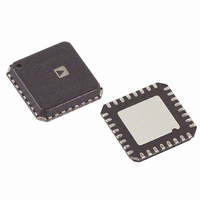AD9514BCPZ Analog Devices Inc, AD9514BCPZ Datasheet - Page 26

AD9514BCPZ
Manufacturer Part Number
AD9514BCPZ
Description
IC CLOCK DIST 3OUT PLL 32LFCSP
Manufacturer
Analog Devices Inc
Type
Fanout Buffer (Distribution), Dividerr
Datasheet
1.AD9514BCPZ-REEL7.pdf
(28 pages)
Specifications of AD9514BCPZ
Number Of Circuits
1
Ratio - Input:output
1:3
Differential - Input:output
Yes/Yes
Input
Differential
Output
CMOS, LVDS, LVPECL
Frequency - Max
1.6GHz
Voltage - Supply
3.135 V ~ 3.465 V
Operating Temperature
-40°C ~ 85°C
Mounting Type
Surface Mount
Package / Case
32-LFCSP
Frequency-max
1.6GHz
No. Of Multipliers / Dividers
3
No. Of Amplifiers
4
Supply Voltage Range
3.135V To 3.465V
Slew Rate
1V/ns
Operating Temperature Range
-40°C To +85°C
Digital Ic Case Style
LFCSP
Lead Free Status / RoHS Status
Lead free / RoHS Compliant
For Use With
AD9514/PCBZ - BOARD EVAL CLOCK 3CH AD9514
Lead Free Status / RoHS Status
Lead free / RoHS Compliant, Lead free / RoHS Compliant
Available stocks
Company
Part Number
Manufacturer
Quantity
Price
Company:
Part Number:
AD9514BCPZ
Manufacturer:
ADI
Quantity:
526
AD9514
LVDS CLOCK DISTRIBUTION
The AD9514 provides one clock output (OUT2) that is
selectable as either CMOS or LVDS levels. Low voltage
differential signaling ( LVDS) is a differential output option for
OUT2. LVDS uses a current mode output stage. The current is
3.5 mA, which yields 350 mV output swing across a 100 Ω
resistor. The LVDS output meets or exceeds all ANSI/TIA/EIA-
644 specifications.
A recommended termination circuit for the LVDS outputs is
shown in Figure 38.
See Application Note AN-586 at
information on LVDS.
CMOS CLOCK DISTRIBUTION
The AD9514 provides one output (OUT2) that is selectable as
either CMOS or LVDS levels. When selected as CMOS, this
output provides for driving devices requiring CMOS level logic
at their clock inputs.
Whenever single-ended CMOS clocking is used, some of the
following general guidelines should be used.
Point-to-point nets should be designed such that a driver has
only one receiver on the net, if possible. This allows for simple
termination schemes and minimizes ringing due to possible
mismatched impedances on the net. Series termination at the
source is generally required to provide transmission line
matching and/or to reduce current transients at the driver. The
value of the resistor is dependent on the board design and
timing requirements (typically 10 Ω to 100 Ω is used). CMOS
outputs are also limited in terms of the capacitive load or trace
length that they can drive. Typically, trace lengths less than
3 inches are recommended to preserve signal rise/fall times and
preserve signal integrity.
LVDS
V
S
Figure 39. Series Termination of CMOS Output
CMOS
DIFFERENTIAL (COUPLED)
Figure 38. LVDS Output Termination
10Ω
100Ω
MICROSTRIP
www.analog.com
1.0 INCH
60.4Ω
5pF
GND
100Ω
for more
LVDS
V
S
Rev. 0 | Page 26 of 28
Termination at the far end of the PCB trace is a second option.
The CMOS outputs of the AD9514 do not supply enough
current to provide a full voltage swing with a low impedance
resistive, far-end termination, as shown in Figure 40. The
far-end termination network should match the PCB trace
impedance and provide the desired switching point. The
reduced signal swing may still meet receiver input requirements
in some applications. This can be useful when driving long
trace lengths on less critical nets.
Because of the limitations of single-ended CMOS clocking,
consider using differential outputs when driving high speed
signals over long traces. The AD9514 offers both LVPECL and
LVDS outputs that are better suited for driving long traces
where the inherent noise immunity of differential signaling
provides superior performance for clocking converters.
SETUP PINS (S0 TO S10)
The setup pins that require a logic level of ⅓ V
bias) should be tied together and bypassed to ground via a
capacitor.
The setup pins that require a logic level of ⅔ V
together, along with the VREF pin, and bypassed to ground via
a capacitor.
POWER AND GROUNDING CONSIDERATIONS AND
POWER SUPPLY REJECTION
Many applications seek high speed and performance under less
than ideal operating conditions. In these application circuits,
the implementation and construction of the PCB is as important
as the circuit design. Proper RF techniques must be used for
device selection, placement, and routing, as well as power
supply bypassing and grounding to ensure optimum
performance.
CMOS
Figure 40. CMOS Output with Far-End Termination
OUT2/OUT2B
SELECTED AS CMOS
10Ω
50Ω
V
S
100Ω
100Ω
S
S
(internal self-
should be tied
3pF












